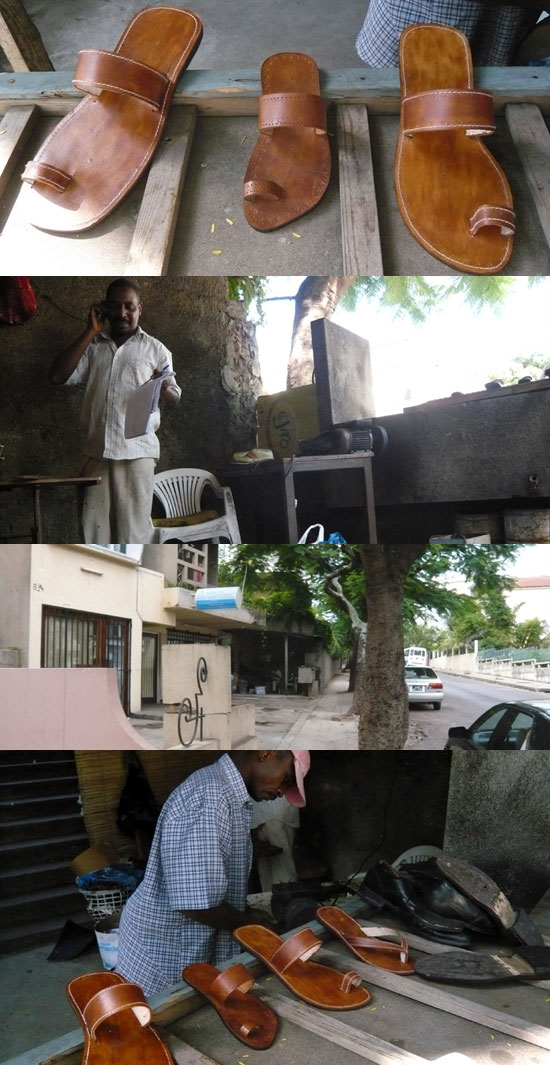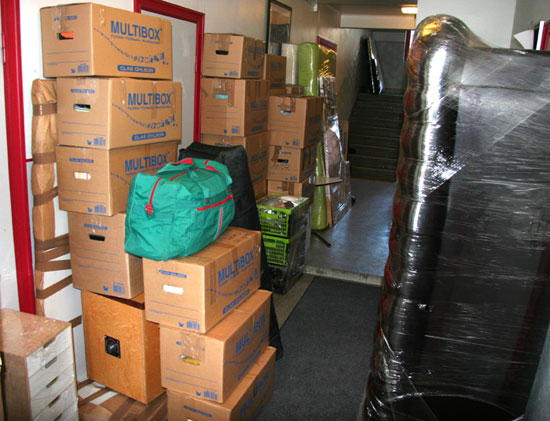ABDUL AND HIS SANDALS
We live in a road named Patrice Lumumba. Like most roads in central Maputo it is named after a political hero. Lumumba was an anti-colonial leader in Africa and the first legally elected Prime Minister of the new Republic of Congo after he helped to win its independence from Belgium in June 1960. Only ten weeks later, Lumumba’s government was deposed in coup. He was subsequently imprisoned and murdered in controversial circumstances. I remember the headlines in the papers in Iceland when that happened. Well, our road crosses Av. Vladimir Lenin, and is parallell to Av. Ho Chi Min and the names are of the same gender. But I want to tell about Abdullah and his sandals.
Up the road on the left hand side, under some steps sits a shoemaker every day working. I became curious about what he is up to and found out that he makes sandals out of leather and sells them to the locals. This interested me and I decided to order a pair for me. The consumer versus producer experience was very intimate. Abdul, the sandal maker took out a writing block and drew around my foot onto it, and we discussed the size of my big toe etc (not the most beautiful in the world as Þórarinn Nevjólfsson). Then I paid him 200 Mtcs (5,5 Euro) and he told me to come next Friday afternoon. When I returned he had made these so beautiful sandals, totally hand made, both looking the same but with that hand made touch where no two things are the same. In a world of ‘experience economy’ this is worth much more than the price one pays for it here. Now, when I pass him we say hello, it is almost as we are friends and I desperately want to order an other pair, discuss with him other styles and comfort. I have already ideas about how I want my second pair to be, and do not have to browse high-street shops to see if there is something that fits my longings. Our Western Economy of mass production and global transport, sweat shops misses this intimacy and fulfillment from knowing and developing. The gap between the consumer (a person) and the producer has become so large in today’s economy that commerce has to redesign into the relationship some kind of an intimacy, like being a Nike-person or some other brand link.
I am often living a kind of a desja vue here in Maputo because what comes before my eyes reminds me so much of my home in the 60′s, where people work very hard in tough conditions with the motivation to improve life. Construction workers mix the concrete on the pavement with shovels and trasport it around in battered wheelbarrows, people are entrepreneural in creating work and commerce like Abdul, Alexander making the straw furniture; there is an other man with a sewing machine located on the pavement. He has helped me make a wind break and fixing trousers, everyone is a maker and a one man business. The pavements are good locations because then you do not have to pay rent for shop area.
If anyone wants sandals just send me a your footprint on a piece of paper. I am not number 45 there.
 April 13, 2009
April 13, 2009
 Posted in: DESIGN, PONDERINGS
Posted in: DESIGN, PONDERINGS  Comments Closed
Comments Closed
STRAW FURNITURE DEVELOPMENT
Alexandro and his gang have started weaving our dining furniture. I had a look yesterday at the progress. I pass them every morning when I go to the local bakery to fetch the morning bread. The frame is made of steel concrete reinforcement and I think Alexandro welds this himself. He is a very positive guy, thinks solutions, with a measuring tape. We had dome difficulty when I arrived with my Western axonometrics, but when he took up his measuring tape things were fine. There is only one fault from my drawings, but that can be solved. The chairs are supposed to be light and the back has extruding metall, since I want to demonstrate the use of material while it is easy to lift the chairs. Here is a picture of one of the guys showing me the situation, and half woven seat on one of the chairs.

 March 26, 2009
March 26, 2009
 Posted in: DESIGN, ISAC - KHiO
Posted in: DESIGN, ISAC - KHiO  Comments Closed
Comments Closed
Furniture out of local straw
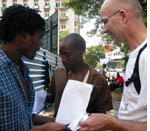 Furniture here is very simple if you like. The guys weave it out on the street, one understands the process immediately by looking at them. Anyone can come with a design, a drawing or just an idea and they tailor it for them.
Furniture here is very simple if you like. The guys weave it out on the street, one understands the process immediately by looking at them. Anyone can come with a design, a drawing or just an idea and they tailor it for them.
Since we are settling in here in Mapto, we need furniture, and what better than trying out the local production method. I have made some simple illustrations after looking at the guys up on the corner of Av. Lenin and Av. 24 July. They sit there all day weaving furniture. The material is local straw, that surely grows in salt water since the bed that Andri has got smells like the beach. But this is possible to warnish out if people do not like the sea smell.
I am going to investigate further the process, try to be allowed to come along to the guys that weld together the concrete steel reinforcement that they use for frame. But the straw is also very strong material on its own although it does not take structural forces. But this I can find out better later. The huts we stayed in last weekend in the small island of Inacha were made of the same straw material and protected us well from the torrential rain that came down in the middle of the night. Here are some images of the production and the dealings with the leader of the gang. Manucho came along with me to help with the language.
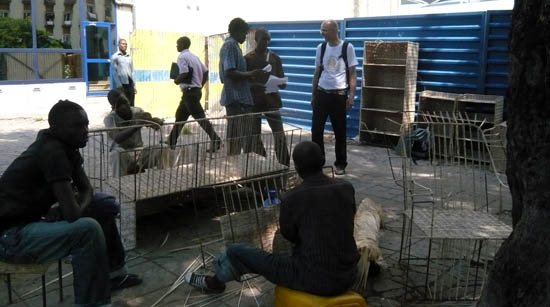
 March 20, 2009
March 20, 2009
 Posted in: DESIGN
Posted in: DESIGN  Comments Closed
Comments Closed
North to South
Finally all our possessions have left dear Oslo. These bags are the last bits in the Airport train out of Oslo. My job now is to stack most of our boxes into a room in Reykjavik and then fly South with Andri. We both agree that we do own too many things, even though we have been going through a ‘trimming down’ period, for example banning IKEA (one of the most rubbish stimulating companies in the world) and mostly concentrating on creating experiences and opportunities. Moving to Maputo is one of those of course. The problem is ones vanity to need to own things, for us mostly books and they are becoming redundant. I have for example always taken with me my favourite books: The Complete Works of Plato, The Complete Works of Aristotle, Sir Bannister Fletcher, but now this material is all available on the net. That is of course great.
While staying in Reykjavik life is in netcafes, meeting friends and research partners and actually I am giving a lecture about design development on Tuesday in my old workplace The Iceland Academy of the Arts.
 March 1, 2009
March 1, 2009
 Posted in: PONDERINGS
Posted in: PONDERINGS  Comments Closed
Comments Closed
Never give up!
 This is what we are told, through life, especially at young age. Is this really true? Quitting is only for loosers. Well, the theory says otherwise. Recentlty I bought the new book by the American economist John P. Kotter named: A Sense of Urgency. One of the revelations that I got from that book was his reference to the fact that those people that get things done, that make things happen are usually people that are good at ignoring the things that do not matter for their task. To see beyond the detail. Those that are good at forgetting the unimportant things. In my expeirence this is so true! It is important not to get bogged down in detail when projects have to move on. Forgetting is fundamental to creativity – total recall is only something that machines can do, and they are not creative.
This is what we are told, through life, especially at young age. Is this really true? Quitting is only for loosers. Well, the theory says otherwise. Recentlty I bought the new book by the American economist John P. Kotter named: A Sense of Urgency. One of the revelations that I got from that book was his reference to the fact that those people that get things done, that make things happen are usually people that are good at ignoring the things that do not matter for their task. To see beyond the detail. Those that are good at forgetting the unimportant things. In my expeirence this is so true! It is important not to get bogged down in detail when projects have to move on. Forgetting is fundamental to creativity – total recall is only something that machines can do, and they are not creative.
Now Kate and Hege have ponted to me an article about quitting that I like. It is in the New York Tmes and the title is: Winners Never Quit? Well, Yes, They Do. At least this article comforts me, because in my life I have quit four safe and good jobs to move on to new pastures. Hopefully this does not stamp me a looser, and maybe I can feel a winner. Time will tell and not me. My companions have every time been surprised that I am leaving the job, but I have thought it worth it to do more things. The article and the book are good. To be recommended.
 February 15, 2009
February 15, 2009
 Posted in: PONDERINGS
Posted in: PONDERINGS  Comments Closed
Comments Closed
LEAVING OSLO
Leaving is easier than arriving. At last our things are gone into a container and off over the ocean. It has been lots of work to decide where everything goes, but it is good regularly to re-evaluate the overloaded Western home. We have lived a non-Ikea life, maintaining that it induces unsustainability. People look at what is for sale and think: “Its ok to buy it, we will throw it away later!”
We have come to the conclusion that living in experiences is more fulfilling than living with things, but alas . . . we still have too many things. It is most difficult to deal with the vices: books and books, papers and tools for making things. But of course today life is impregnated with gigabytes, rearranging backups and servers to make sure that we will have access to our ideas stored in gigabytes. But, what a relief to live simpler for a while – until things start arriving at us like flies to a cows shit in the field.
 February 10, 2009
February 10, 2009
 Posted in: PONDERINGS
Posted in: PONDERINGS  Comments Closed
Comments Closed
Its a DogS Life
Well, things are tough in Maputo and also in Oslo. We are living in chaos, but surprisingly not so much anxiety in it. In Oslo everything is in boxes, most of our things go to our flat in Reykjavik and will be collected on Monday. That means packing. The packing itself is not the biggest problem, it is the taxonomy of what goes where? What do we desperately need in Mozambique and what do we need in Reykjavik and what is to be in Oslo. To Africa we only take 20 kilos per person plus hand luggage. I am sending teaching material to the school in the post.
Luckily we did a bit of a cleanup in our life when we moved to Oslo 4 years ago, selling the house and getting rid of many of the material things. That was also part of the trend of having less things and enjoying more events and activities. Experience is nicer than things. We have definitely come to that conclusion. The biggest vice is books. Now Google is scanning like hell and I am leaving all the classics in Iceland since they are available on the web. No more carrying of the complete dialogues of Plato and Sir Bannister Fletcher is not needed in Africa since he did not consider Africa part of architectural history.
We are operating with various projects, mostly linked on web, in networks with many people, most of whom have become friends. Fortunately is our work not so linked to localities but to activities. This might sound strange, but . . . Like now we have two projects to do in Maputo and we are very eager to work on those. At the same time are we developing the DIG-Equality project, have got funds for first startup and dissemination work. I am designing a farm in the West of Iceland, a private house on the outskirts of Reykjavik, Networking various social and strategic projects, I have to write the bid for the Nordic-Baltic Network project ‘Cirrus’ that has to go in before the 1st of March, and I have a working meeting in England next week about a book that we are establishing. Oh! And a few lectures to prepare etc. Most of this happens on computers, with the use of mail and web systems. The only really important thing for us is internet to operate and also to link ourselves emotionally. Life is great and should never be too easy.
 February 7, 2009
February 7, 2009
 Posted in: PONDERINGS
Posted in: PONDERINGS  Comments Closed
Comments Closed
Doing Good Projects
To Do Good!

To do good projects have been on the increase recently. Social responsibility and ethics have taken over from profit and business innovation as the most discussed issues in design schools. The world of Al Gore, Bono, Architecture for Humanity and Design Without Boundaries has entered the design schools and even to some extent the design centers and media. Today, when visiting design fairs one wonders about the motivation of designers and producers displaying things that not many have use for (see previous blog about the Stockholm Furniture Fair).
Implementation of Doing Good Design
But many projects wanting to do good for society and the environment have landed in difficult pitfalls during implementation and execution. The utopian driven Romanticism that one senses in the studios meets trouble when it hits reality. I wonder if we do not need to introduce a different working environment and competence into the design education.
Short Design Perspective
 I am not going to disseminate design history here, but a stepping stone history can be seen this way: Design gained its independence trough the work of William Morris and many others in the end of the 19th century. It was born out of manufacture and mass-production of every day things that previously was made by local craftsmen. The manufacture was based on the philosophy of the crafts, maybe culminating in the Bauhaus ‘crafts to industry to multi production’ musical.
I am not going to disseminate design history here, but a stepping stone history can be seen this way: Design gained its independence trough the work of William Morris and many others in the end of the 19th century. It was born out of manufacture and mass-production of every day things that previously was made by local craftsmen. The manufacture was based on the philosophy of the crafts, maybe culminating in the Bauhaus ‘crafts to industry to multi production’ musical.
National Design Policy (Bella Centre, Norsk Form, Design Museum, etc)
After the Second World War national design activism gained momentum resulting in the establishment of design councils, design centers and national design policies. I remember the Design Centre in Haymarket, London displaying ‘good design’ items, various exercises in form with application to function. Now, most national capitals and major cities have design centers that promote something that is named ‘Good Design’ based on advice from people that had the licence for proper form, proper materials and proper designers. All very boring. 70′s, 80′s and 90′s design fashion then developed into a celebrity culture of faces on covers of magazines, more idiotic designs like a sofa for stupid prices designed by Saha Hadid, Pawson etc. Everyone
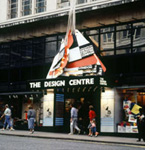 competed to outdo the others in extravagance. I am not blaming people directly but the zeitgeist. I was an architect in the late yuppy 80′s and did some rather cracy things. My only excuse is that it is possible to change. We have many examples of the same like Tim Brown talking about toothbrush design in the Intersections conference 07: “When I think about this, I kind of get a little bit depressed. It makes me feel less great about what I do as a designer.” Same goes for Philip Starck in Ted Conferenceapologizing for his actions in the Nineties.
competed to outdo the others in extravagance. I am not blaming people directly but the zeitgeist. I was an architect in the late yuppy 80′s and did some rather cracy things. My only excuse is that it is possible to change. We have many examples of the same like Tim Brown talking about toothbrush design in the Intersections conference 07: “When I think about this, I kind of get a little bit depressed. It makes me feel less great about what I do as a designer.” Same goes for Philip Starck in Ted Conferenceapologizing for his actions in the Nineties.
Romantic Socialism
Morris was of course a socialist, meaning to make the world better and more beautiful for the middle classes, like IKEA has managed to succeed with. Le Corbusier was a devoted salon communist, proposing social solutions in the city and the home while working for the affluent. The 60′s and the 70′s were dominated by architectural projects in housing and urban planning wanting to create social solutions for the every-man (whoever that is?). This all culminated in determinism for the masses and architects and planners became the most hated professions in the late Seventies and ultra self indulgent Post Modernism took over. I was one of them. I remember a slogan in our office: ‘If you can make it more complicated, do so!’
Innovation
Around the millenium commerce came into the force in the design field and innovation became the most used word. Governments started to look at design as part of innovation, we were courted by business and industry as the new way to make profit. And designers and design theorists participated in this, we took part in many projects and research into innovation and the creative industries. Out came the Cox Review, funds from the Nordic Innovation Centre, co-projects with the business schools became the norm. I have participated in such projects, sometimes being surprised that I was the only designer in the group! The US magazine Business Week asked recently ‘Are the Design Schools the new Business Schools?’
Environment, Society and the Developing World.
But underlying the Noughts has simmered the realization that things are maybe not going so well, and the small group of eccentrics actually might be right. With awareness of global issues like climate, developing countries resulting in organic commerce, ethics, fairtrade etc has come into force. I have been running projects where my students of design have worked in groups with students from business universities since the beginning of this century. The orientation of the projects has changed dramatically in the direction that now over 90% of the projects involve ethical, social and climate issues while the early days the projects were much more commercial. The worst case being a project in producing and selling stencils for the barbering of ladies pubic hair!
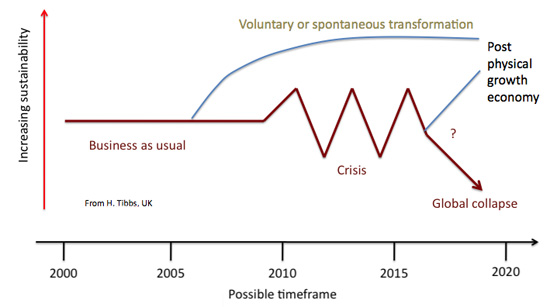
The futurist H. G. Tibbs proposed in 1998 how things might happen in the years after the millenium. The diagram shows his ideas, and it seems that his proposal was quite right. There has been an underlying anxiety about where we are heading and many spontaneous activities have resulted. This spontaneous activity that he proposes results for example in various ‘To Do Good’ projects. They are driven by Utopianism. A need to be nice to ‘the other’ like Madonna and many celebrities adopting African children etc. My opinion is that very many of these projects do not succeed because they do not have anchored strategies and do not know how to act in complicated political situations and cultural diversity. The actors struggle and in many cases decide to do ‘safe’ projects like helping South-American women in making toys for children. But the toys have no way of reaching the market that needs them and much of the Western market has actually no need for the products. This results in disappointment and Western subsidy of products that just increase the rubbish in the modern Western home that is full of Playstations and mobile phones.
It is fine to walk around with a basket made by African women. It is fine to eat organic Kenyan beans. It is fine to adopt third world children. These are all small acts of good, but the task is so much bigger and time is too short and most of these acts are self indulgent and in some cases reinforce the differences between the rich and the poor. They are bread-crumbs from the affluent.
Friend Richard Kroecker in Halifax came for a visit to tell us about the Pictou Landing Health Centre he produced in a remote village in Canada. Most of the difficulties that they came against and the tricks they had to do were to deal with Canadian government standards and procedures. Kate Stohr from Architecture for Humanity came here to tell us about their work and in her explanation about the project in post-Catrina she told about planning laws, financing, governmental agencies. The house design was actually not the most important task!
Design and Infrastructure
The design schools do not consider infrastructural issues very important. The schools are still based on the old Form/Crafts/Products principles. The teachers are many educated in art schools where the idea of the Renaissance heroic artist still prevails. The design centers are similarly driven by the same policies and design agencies that want to do social projects do not realize the implications of complex politics, marketing and cultural differences. The design schools have more focus on entrepreneurship, but mostly towards business and industry. This is good, but issues of social entrepreneurship are needed. I have been involved in service design projects and they, while they are about people and services, do concentrate on profit for the service provider more than the benefit for the user.

I have made two diagrams of project development. The first one shows the ideal project where the process goes from start to end in a beautiful direct line representing actions and results. This is a possible scenario for the individual craftsman who through rigourous training can be trusted to deliver results, like a good piece of a ceramic pot in the controlled situation of the ceramic studio.

The second diagram (inspired by the French philosopher Gilles Deleuze and furniture designer Bernard Cache) shows the actual process, where external factors direct the project off course to various problematic situations. For those that are not driven by vision and with entrepreneurial skills it is a difficult process, lots of anxiety and trauma, with pitfalls and trouble all the way. No wonder many of the designers do not risk taking on such a project. It is better to create simple projects that can be proudly displayed in galleries rather than implemented in society where often the results are invisible to the design media. Those designers have less chance to have their face on a cover of a magazine, given prices for ‘Good Design’.
The design and crafts schools and the practical reality after school are seen as protected studios and worshops, almost like sheltered work place for handicapped people rather than social, political and entrepreneural activities for the good of society.
————————————————-comments———————————————————–
 It has to do with the fact that designing ends at the prototype (whether it is an object, or a concept, or a “transformation”) as such it often fails to fully engage with the complex processes and issues of implementation.
It has to do with the fact that designing ends at the prototype (whether it is an object, or a concept, or a “transformation”) as such it often fails to fully engage with the complex processes and issues of implementation.
Socially responsible project “failures” that I have experienced have often had one of two sources: the failure to be implemented or the failure to scale the implementation in order to have measurable impact.
My health financial information project for Chicago Cook County Bureau of Health Services failed because the employees directly blocked its implementation through stonewalling. Why did they act that way? The project would have made more transparent their processes, which they wanted to keep private, so they sat on the warehouse of designed artifact systems and processes until I ran out of energy trying to both adapt the design to the bureaucratic culture, yet bring about change in the culture. As an anthropologist, the most challenging thing to do is to change institutional cultures.
Thinking of the Design for Democracy example, it is mired by the fact that it cannot scale to have national impact, although it has been approved by the Fed gov as the national standard for ballot design and polling place information and the templates to implement the system is widely available. AIGA, the sponsoring organization, does not have the resources (staff and money) to convince all 3,421 counties to adopt the standard. The Fed government cannot mandate the changes due to the Constitution. So even though it has been successfully implemented, it will lag in its ability to scale.
But failure is always a question of for whom and under what time frame. Is DforD a failure because it will take 10 years to have full acceptance instead of 2-3 years? If Cook County rolls out the design system because a new Lt. Government applies pressure, will it still be a failure?
Perhaps socially responsible projects “fail” because the temporal scale of change is longer than the temporal engagement of designers.
 Brilliant question and response, so far – I agree with Dori T. insofar as timescale…this is not confined to socially-oriented projects – it is also true in many governmental projects [e.g. the last 7 major computer systems in UK] that failed through their complexity<?>…..also because small deceits, optimisms and incompetences remained invisible or seemed trivial until the whole scheme was switched on. We are looking at a redesign of design to include self-steering of the whole co-design system…..[must get some sleep now:)
Brilliant question and response, so far – I agree with Dori T. insofar as timescale…this is not confined to socially-oriented projects – it is also true in many governmental projects [e.g. the last 7 major computer systems in UK] that failed through their complexity<?>…..also because small deceits, optimisms and incompetences remained invisible or seemed trivial until the whole scheme was switched on. We are looking at a redesign of design to include self-steering of the whole co-design system…..[must get some sleep now:)
 I wonder if this is to do with the how design has been implemented previously in society.
I wonder if this is to do with the how design has been implemented previously in society.
Very practical implementation of a logo, or here is a new chair. These are easy to understand, but not necessarily easy to measure the effect. (Does a new chair really make the world a better place? etc.) Well there has been some quantitive measurement of the effects of design as well national feedback from things like the Cox Report etc.
However, Socially Responsive Design, or the implementation of ideals is harder to measure. How do we measure design that changes our behavior as human beings? Where is the evidence for the effect of this sort of intervention?
 Well…ok. Let’s talk turkey.
Well…ok. Let’s talk turkey.
If you look at the batting average of commercial firms– how many designs they take through schmatics vs. how many they see through fruition. I’d wager it’s about 10 unrealized projects to every 1 realized project.
At www.architectureforhumanity.org, we have the same batting average. We’re about 10 to 3…and then only because we don’t have the manpower to take more projects through pre-development.
So, i think you have to look at it from a different lense.
Also many projects do good without being do-gooder projects. We should not underestimate the value of sustainable design in the construction of offices, warehouse space, and the manufacture of products.
We’ve seen a seachange in the way the industry works. We are helping our clients become better stewards… so again, look out outcomes not output.
kas
 February 2, 2009
February 2, 2009
 Posted in: DESIGN, PONDERINGS
Posted in: DESIGN, PONDERINGS  Comments Closed
Comments Closed
Social Design and Relational Design
 I am an architect. Architecture deals foremost with people, not buildings. Architecture deals with how people live, interact, protect themselves etc. As an architect have I never been able to create structures and plans without people. Since I am brought up in theater my way of designing has been to make up plays of life; theatrical events and actually sometimes based my private houses on well known plays that I sat under as a child while my father, an actor in the Reykjavik City Theatre, was rehearsing. One of my better known private house designs in Iceland is based on the play by Anton Chekov: THREE SISTERS, because the family that I designed it for felt like that play.
I am an architect. Architecture deals foremost with people, not buildings. Architecture deals with how people live, interact, protect themselves etc. As an architect have I never been able to create structures and plans without people. Since I am brought up in theater my way of designing has been to make up plays of life; theatrical events and actually sometimes based my private houses on well known plays that I sat under as a child while my father, an actor in the Reykjavik City Theatre, was rehearsing. One of my better known private house designs in Iceland is based on the play by Anton Chekov: THREE SISTERS, because the family that I designed it for felt like that play.
 Why do I have to say this? To clarify the fact that architecture is Social Design. The first town planners were creators of societies, looking out for infrastructural and political solutions for the good of the people. A good example is Pericles, thearchitect of the Acropolis and an influential developer of the society. Often these early planners were military leaders and city planner in the same person. But the situation is more complex today.
Why do I have to say this? To clarify the fact that architecture is Social Design. The first town planners were creators of societies, looking out for infrastructural and political solutions for the good of the people. A good example is Pericles, thearchitect of the Acropolis and an influential developer of the society. Often these early planners were military leaders and city planner in the same person. But the situation is more complex today.
The newly named field Social Design bases its existence on doing social good, for the benefit of society, human relations and sturctures. As stated in Wikipedia: “as the creation of social reality; design of the social world and the shaping of products and services.”
 The fundamental definition of design is: “To make the every day easier, simpler and more beautiful”. It is about humanizing processes like technology, communication, services and strategies. As such, design is fundamental to all human activity. Design has always a social agenda, but this has sometimes been forgotten, for example when services and structures have been created by industrial designers, architects, city planners creating structuralistic solutions based on technical expertice or theoretical functions where relations between structures and processes has become fundamental and not the relation of people. In a sense, the receent term Social Design has come up, to differentiate it from technical design that has often evolved in technical design schools located in engineering faculties.
The fundamental definition of design is: “To make the every day easier, simpler and more beautiful”. It is about humanizing processes like technology, communication, services and strategies. As such, design is fundamental to all human activity. Design has always a social agenda, but this has sometimes been forgotten, for example when services and structures have been created by industrial designers, architects, city planners creating structuralistic solutions based on technical expertice or theoretical functions where relations between structures and processes has become fundamental and not the relation of people. In a sense, the receent term Social Design has come up, to differentiate it from technical design that has often evolved in technical design schools located in engineering faculties.
All design is in its essence active, it thrives on doing, it is visionary and solution oriented – to quote the designer Richard Seymour in the 2007 Intersections Conference: “If you are not positive and with a belief in the future then you should do something less dangerous than design“.
 Relational design. In his book, RELATIONAL AESTHETICS, Bourriaud says ‘Artistic activity is a game, whose forms, patterns and functions develop and evolve according to periods and social contexts’. The case is the same with many design solutions, especially those that deal with situations, like the design of events, space, products and furniture. I am very excited about the development of furniture/product design and interior architecture over the coming years, because the fields seem to have come to saturation. No more of these things are needed in the Western World at least, people are sick of new products every year, extreme makeover shows etc. (see previous blog) There is a need for things and spaces that have stronger emotional values. Thus the interest in relational design and art. I have been following various projects that could be classified as Relational Design, where peope gain attachment with products and services resulting in social contentment and often improved social interaction. I will tell about some of these projects later.
Relational design. In his book, RELATIONAL AESTHETICS, Bourriaud says ‘Artistic activity is a game, whose forms, patterns and functions develop and evolve according to periods and social contexts’. The case is the same with many design solutions, especially those that deal with situations, like the design of events, space, products and furniture. I am very excited about the development of furniture/product design and interior architecture over the coming years, because the fields seem to have come to saturation. No more of these things are needed in the Western World at least, people are sick of new products every year, extreme makeover shows etc. (see previous blog) There is a need for things and spaces that have stronger emotional values. Thus the interest in relational design and art. I have been following various projects that could be classified as Relational Design, where peope gain attachment with products and services resulting in social contentment and often improved social interaction. I will tell about some of these projects later.
Images: Three Sisters / Pericles / Richard Seymour / Grass chair that will only last through emotional attachment to the owner
 January 27, 2009
January 27, 2009
 Posted in: DESIGN, PONDERINGS
Posted in: DESIGN, PONDERINGS  Comments Closed
Comments Closed
Leaving Oslo, phase one
The first phase of our project after all the applications, planning, interviews and program participation is to leave dear Oslo. We have lived here for 4 years now, a very family friendly place with lots of new friends. We have been to dinners and invited for coffee, going around shopping things to take away, strengthening our hard drives for file storage.
Thursday Soley leaves for Porto in Portugal to do a language course in Portugese for the whole of January. That is fortunate since we do not speak the language at all. Dori has been to Maputo one time before for starting up ideas of the project between KHiO and the future ISAC.
Now, Soley is going there to learn the language in a crash course. She goes with Brit from the Frederiksstad Culture School and with Kristine who is going to work with the dance school in Maputo. Surely they will get lots out of the course.
We have packed half our flat, many of the books are in a store in Iceland by now, but lots of stuff still lies about. The pictures show Soley evaluating the 20 kilos that she is allowed on the plane.
 January 7, 2009
January 7, 2009
 Posted in: PONDERINGS
Posted in: PONDERINGS  Comments Closed
Comments Closed
The Problem with Big Green
Green is getting mainstream… Big Green! Here is an article on worldchanging with an interview with Dr. Tom Crompton, author of the WWF recent report 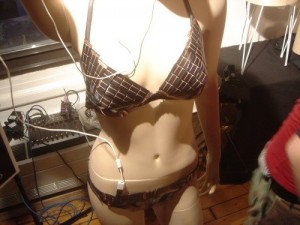 Weathercocks and Signposts: the environment movement at a crossroads The problem with the small green steps is that it doesn´t seem to lead to bigger steps and a deeper care for the environment and nature, there is even the danger that the small green steps are environmentally unfriendly because it can lead to the idea that we don´t need the BIG environmental steps we REALLY need. Here is one interesting bit of the interview: “To get beyond the small steps and change the fabric of the debate, Crompton says, we need to engage the values that underpin public discussion. For example, appeal to people’s sense of connection to the natural world. And he insists that this isn’t the same as heartstrings-tugging approaches we’ve seen before. Asking the public to save the panda out of moral obligation, because we feel guilty, is not the answer. What previous campaigns have missed is that the world we hope to build as we progress towards sustainability is not just a world that offers a better quality of life, it’s a world that’s more in alignment with the sort of fundamental values (from concern for our children to connection to nature to a sense of duty) that most define us as human beings. When we are at our best, we are capable of extraordinary things.”
Weathercocks and Signposts: the environment movement at a crossroads The problem with the small green steps is that it doesn´t seem to lead to bigger steps and a deeper care for the environment and nature, there is even the danger that the small green steps are environmentally unfriendly because it can lead to the idea that we don´t need the BIG environmental steps we REALLY need. Here is one interesting bit of the interview: “To get beyond the small steps and change the fabric of the debate, Crompton says, we need to engage the values that underpin public discussion. For example, appeal to people’s sense of connection to the natural world. And he insists that this isn’t the same as heartstrings-tugging approaches we’ve seen before. Asking the public to save the panda out of moral obligation, because we feel guilty, is not the answer. What previous campaigns have missed is that the world we hope to build as we progress towards sustainability is not just a world that offers a better quality of life, it’s a world that’s more in alignment with the sort of fundamental values (from concern for our children to connection to nature to a sense of duty) that most define us as human beings. When we are at our best, we are capable of extraordinary things.”
 January 2, 2009
January 2, 2009
 Posted in: DESIGN, PONDERINGS
Posted in: DESIGN, PONDERINGS  Comments Closed
Comments Closed
DINNER IN NEWCASTLE
We went for a Chinese in Newcastle while attending the Intersections Conference. The conversation flowed and the red wine flowed with interspersions of great dishes. Allan, one of the contributors of Core77 had to text his wife and lo and behold: his iphone appeared. He said that he had seldom in his life had as much attention. Phone comparisons started, especially beetween the West and the gear of the two Japanese design academics: Hiroshi Imaizumi and Tadanori Nagasawa from Musashino Art University. John Thackara had to have a go as well. Shaky phone-driven images turned out.
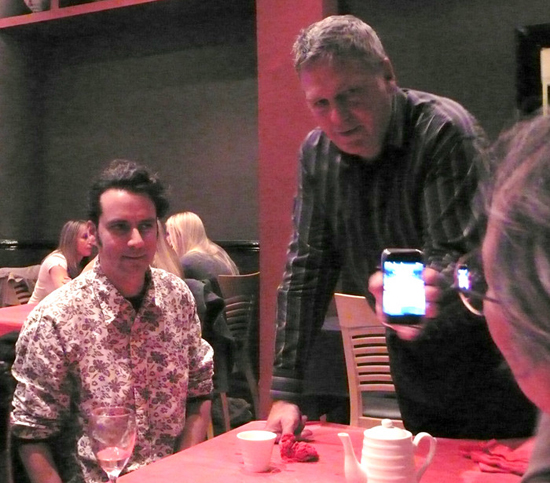
 November 30, 2008
November 30, 2008
 Posted in: DESIGN
Posted in: DESIGN  Comments Closed
Comments Closed
21st August 2008. Ken Robinson always fantastic

Among the ‘must see’ lectures in our great new world of endless available lectures is Ken Robinson’s talks! Both brilliant and fun. His subject is education and the need to transform education. ‘We are still educating our kids according to the ideology of the Enlightenment and the Industrial Revolution – killing their creativity. There is a new age now, creative one, and we need the creative people to face the vast challenges of today – the industrial ideology will not get us anywhere in that matter!’ Sir Ken Robinson is the recipient of the RSA Benjamin Franklin Medal 2008. Here is an hour long lecture at that occasion worth every minute of watching. And here is his fantastic lecture at TED which we have watched and used often. When we were watching this lecture, our son, then 10 year old, heard bits of it including some of our discussions about it (kids always hear and understand more than you think) The day after he went to school rebellious and told all his friends that the school was destroying their creativity! One of his schoolmates is a very creative and artistic boy. We heard later from his parents that in the evening he got nightmares and couldn´t sleep because he was so scared about his creativity being destroyed.
 August 28, 2008
August 28, 2008
 Posted in: DESIGN, PONDERINGS
Posted in: DESIGN, PONDERINGS  Comments Closed
Comments Closed
THE WORLD ACCORDING TO AMERICANS
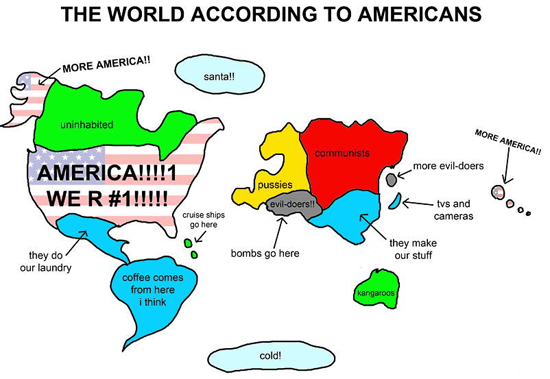
Watching CNN or reading some US newspapers often gives me the shivers because of the narrow interests reflected. I have since a little boy during the Cold War been vary of any newspaper pertaining to be neutral. At least in Reykjavik during that time no newspaper was neutral. The placement in the paper, if it is on the front cover or in a small column inside. I got this map on stumble. It is uncomfortable in two ways: a) an amazing arrogance against a nation with high level of achievement in the arts and research. b) if there is some truth in it we have to worry greatly. Now the question becomes: what presidential candidate (or current president) comes closest to using this kind of a map?
 March 1, 2008
March 1, 2008
 Posted in: PONDERINGS
Posted in: PONDERINGS  Comments Closed
Comments Closed
COMMUNICATING STATISTICS
There is not always a sync between knowledge/information and communication. A whole of a lot of knowledge is being produced with registered statistics stored in numbers, but the communication tools are often very bad or non existing. This is one of the areas I find so challenging within my field of visual communication. Thousands of interesting researches, essays and projects are being worked on but the results created often get hidden in reports on shelves in libraries or in thick proceedings documents that very few people have time to read through and no-one enjoys. The software Gapminder is an example of how it is possible to communicate knowledge (and maybe the most boring knowledge of all: statistics!) in a very interesting way. The program uses the classical scientific graph methodology (with x and y axis) that we are used to when looking at statistics. Each country is represented by a bubble in a size related to its population. The bubbles are animated over time and it is easy to compare statistics both within countries and between. The elements that control each axis are changeable to execute various factors. The actual designed graphics could be better but in comparison to presentations in the university sector they are beautiful! The program is developed by Hans Rosling, a professor of global health at Sweden’s Karolinska Institute. Rosling asks why we aren´t using all this data that is available to be able to understand how societies are developing and changing? “We have the data, we have the design tools!” But we need open access to the data and the search tools to get it together and compare in different ways he says. In his work he focuses on dispelling common myths about the developing world and he wants to maintain how wrong it is to talk about “us” the first world and “them” the third world. To Rosling there is no “them”! To talk about Africa as one country is totally absurd. There is such a difference within Africa that it is impossible to talk about it as a whole and for the developed part of the world to use one and the same aid strategy. One of the very interesting facts Rosling talks a lot about is how family planning and economic development go hand in hand. And family planning is very connected to women´s rights and education. On the fantastic TED website there are two amazing presentations by Hans Rosling, important both to those interested in world and development affairs but also to those interested in visual communication. The earlier one is from 2006 called Debunking third-world myths with the best stats you’ve ever seen and the second from 2007 called New insights on poverty and life around the world On the Gapminder website it is also possible to see several Gapcasts Google has bought the Gapminder program but the Gapminder Foundation still maintains it. Hopefully that cooperation will strengthen the development of the program and possibilities to make data come alive. Here is an interactive test site where it is possible to play with the program, change the axis and select countries to look at.
 January 12, 2008
January 12, 2008
 Posted in: PONDERINGS
Posted in: PONDERINGS  Comments Closed
Comments Closed

